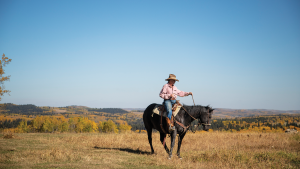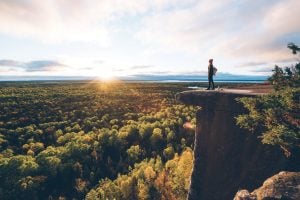
Environment
Inside the fight to protect the Arctic’s “Water Heart”
How the Sahtuto’ine Dene of Déline created the Tsá Tué Biosphere Reserve, the world’s first such UNESCO site managed by an Indigenous community
- 1693 words
- 7 minutes
Travel
Experiencing living history at Métis Crossing, a one-of-a-kind destination for Métis people to share Métis stories

On the north bank of the North Saskatchewan river (or Kisiskâciwanisîpiy — “swift-flowing river” in Cree), 14 kilometres south as the crow flies from Smoky Lake, Alta., a thick blanket of snow cloaks a land covered in a riot of ancestral footprints. Footprints of all the people who have crossed here, gathered here, harvested here, over the past 10,000 years. Hoofprints of the bison that was king in this ancient landscape. Scamperings of hare and squirrels, soft-padding prints of lynx, stomps of bark-grazing moose.
Bison have shaped the landscape here. Or, they did. We look across the river that has been a crossing place for thousands of years. For diverse peoples from the Cree to the Inuit to the Dene and, later, European settlers and Métis. It was a place to trade goods. A place to meet. A place to cross the river.
And it still is. Now, the river can be crossed by car, across the Smoky Lake AB-855 Bridge. And instead of traffic made up of thousands of Red River carts (a Métis cart pulled by oxen, horses or mules), here we are: a group of visitors with snowshoes on our feet and capotes (Métis coats, traditionally sewn out of Hudson’s Bay Company blankets) on our backs. We’re here to visit Métis Crossing, a cultural gathering centre and tourist destination on the banks of a river rich with history. A place for Métis people to tell Métis stories.
The 40-room lodge that now stands at Métis Crossing was built on a historical Métis river lot. “When they originally settled all along here, they had already surveyed these river lots,” says knowledge holder Lilyrose Meyers. “Then they asked the Métis to come and there were over 3,000 Red River carts that came from the Red River to come and settle here. And that’s who we are. That’s where we descended from. Our ancestors.”
The river views, as you look out of the window of your cozy, accessible room, are the same today as they were for those who came before you. You can’t help but imagine the layers of history in this place. Now, this river lot holds a cultural gathering centre, the lodge, sky-watching domes and a wildlife park. Offerings include cultural experiences, Indigenous-inspired cuisine, camping and myriad activities, from summer paddling to winter skiing and snowshoeing.
We’re here to learn from Lilyrose, 71, from Buffalo Lake Métis Settlement and from Danielle LaRose, Métis actor, musician and accomplice to Lilyrose as she weaves tales along ancient traplines. Lilyrose, who wears a perpetual grin, is kitted out in a thick-knitted fleece tied around the middle with a Métis scarf; Danielle dons a cream-fringed capote, her hair wrapped in a kokum scarf decorated in a pattern that honours early Ukrainian settlers’ relationships with Indigenous Peoples. The two women hoot with laughter as they lead us down the trail, kicking up powdery snow that glitters in the sun.


On the far bank of the river, a thick layer of trees slopes up toward the sky, almost black against the snow. But when the bison ruled, says Lilyrose, there were no trees. “They didn’t leave a tree standing. The only time that you’d see trees would be the little trees along the river. But they had crossings here.” The bison knew how to cross the river.
At their height, the bison — or “bufloo” in Michif, the language of the Métis — numbered 65 to 70 million in North America, ranging across huge swathes of land, from the Northwest Territories, Alberta, Saskatchewan and parts of Manitoba in what is now known as Canada, down through the central U.S. states as far south as Texas. “Unless you were an antelope or somebody who can run really fast, you wouldn’t be messing around in here because that’s where they ruled.”
The last bison hunt was in 1878 at Tail Creek, says Lilyrose. By that time, the hunt was pretty much a failure. And though the diverse Peoples who had relied on them persisted, the near-extinction of the bison — one of the largest and most rapid losses of a critical industry in the continent’s history — has had lasting impacts on Indigenous Peoples.
Indeed, a recent study in The Review of Economic Studies showed that even today, a century and a half after the near extinction of the bison, the income of formerly bison-reliant nations remains 25 per cent lower than non-bison-reliant Indigenous nations.
Without the bison to shape the landscape, there was nothing to stop tree seeds, some carried on the winds, some dropped by birds, and some purposely planted by settlers, from taking root. Maple, spruce, birch. Lilyrose pauses, shrugs, and laughs ruefully. “Guess what? The forest’s here!”
You manage the land; you don’t do what they did to the buffalo.
We follow Lilirose and Danielle down a hill towards a stand of maple trees. Old, but only settler-old. Even the spruce was planted. Now its tips are used in pickles, in tea.
In amongst the brush, a tangle of bright red, sharp against the white snow, grey birch. Willow bark, a favourite snack for moose, one animal that benefitted from the bison’s absence and found its own place in the changed landscape. Before, when trees were scarce, there wasn’t much for moose to eat, explains Lilyrose. Now there’s lots to snack on.
And for humans to make things with, too. Red willow baskets in the springtime. Bark scraped off and dried, mixed with tobacco to make kinnikinnick, which can be smoked or used in medicine or ceremony. “The berries, you can eat them, but I won’t eat them,” says Lilyrose, pulling a face. “They taste terrible. Leave it for the birds.”
You get to know all of these plants when you’re out on the trapline, explains Danielle. What they’re used for, when they’re used, when to harvest them. The process of laying out the traplines in patterns, coming back to check what you’ve caught, re-laying the traps, takes days. There are a lot of different creatures to be trapped, muses Lilyrose, looking up at the sky as she lists off what she calls the “long hair.” Squirrel, fisher, wolf, coyote, lynx, pine marten, wolverine.
“I always say: we always managed the land for years. Before that, for thousands of years, the First Nation[s] managed the land that was there. They used what they needed and they never overhunted because when you have a big family at home to feed and those kids are going to grow up, you’ve got to leave something for them. And that’s what’s very important,” says Lilyrose.
“You manage the land; you don’t do what they did to the buffalo,” she says “That’s why, when you manage something, you look after it, because you’re responsible for that.”
The sun is getting low, over the gold-encrusted river as we crunch back along the trail. Before we take off our snowshoes, Lilyrose and Danielle pause at the top of the hill. The river is at our back, reflecting off Lilyrose’s sunglasses, pale rosy light on Danielle’s face as she tells us: “You have now walked in the footprints of the ancestors — and you’ve left your footprint.”

Just over the fields, there are hoofprints in the snow. Walking in the hoofprints of their ancestors. The mighty bison, returned to the landscape, their home. White, wood, plains.
We crest the hill and we see them. Stocky. Stoic. Unbothered. Happy. In their lane. Flourishing.
“This kind of snow, they’re happy, happy, happy,” says Len Hrehorets, happily. Hrehorets is a rancher, a self-described “guy with a black cowboy hat,” and the partner behind Visions, Hopes and Dreams — the wildlife park at Métis Crossing, which saw the return of the bison to the land their ancestors had once roamed. “They’re just an animal that is made for this country… It could be a wind chill, 40 below and that, and my buffalo’d be running up here bucking and kicking.”
Hrehorets’ ancestors made their own footprints in the snows of this landscape when his grandfather came to Canada from Ukraine in 1906 at six years old. The family had planned to build a house, but a big snowstorm came in. “They dug holes in the riverbank and they lived the whole winter in the riverbanks,” says Hrehorets. “They lived off the river. And they worked with the Métis. And the Métis had nets and traps; they fished out of the river.”
Like his family before him, Hrehorets has worked with the Métis to build a wildlife park that would see the return of the bison. Hrehorets already had the bison, having kept them since 1981. It was his daughter who was the inspiration for Hrehorets building the park in the first place. She was in a major car accident and became paralysed from the waist down. “I started making a park because I wanted to do something for her,” he says.
Once he heard that a Métis gathering centre was being built on the land adjoining his, he introduced himself. “I said: I got white bison, white buffalo, wood buffalo, Plains buffalo, big heavy horses. And I said I got land joining you, let’s build this park.”
So, the rancher and Métis Crossing went into partnership with each other and officially established Visions, Hopes and Dreams at Métis Crossing Wildlife Park in September 2021.
“How many buffalo do I have today? Just around 5000,” Hrehorets says proudly.
To see a white buffalo is rare, sacred even. For many nations on the Plains, to see a white bison is a powerful spiritual experience, a good omen, a sign of hope. In the wild, maybe one in 10 million bison are white.
Even though the recessive genes in the herd of white bison in this park are deliberately selected, it feels very special to see them.
The sky is losing its light, the clouds stripes of slate, darkening to a bruised purple-violet at the horizon. The shaggy coat of one white bison is creamy in the deepening gloom as it picks its way across the snow. Its brown nose shining, horned head lowered against the wind, it’s making its own tracks in a network of trails. These prints in the snow are those of hope.

Are you passionate about Canadian geography?
You can support Canadian Geographic in 3 ways:

Environment
How the Sahtuto’ine Dene of Déline created the Tsá Tué Biosphere Reserve, the world’s first such UNESCO site managed by an Indigenous community

People & Culture
The ultimate goal of vaquero horsemanship is to produce a “finished” horse: an exceptionally responsive animal that is a true partner to its rider

Travel
The new movement building flourishing tourism hubs across Canada – one sustainable example at a time

People & Culture
The story of how a critically endangered Indigenous language can be saved